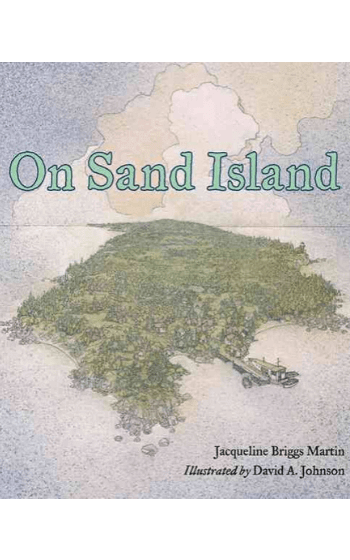
- Publisher: Houghton Mifflin
- ISBN: 978-0618231515
- Published: January 1, 2003
Illustrated by David A. Johnson
Houghton Mifflin, 2003
Find @ Your Public Library
About the Book
From the front book flap:
In the deep blue waters of Lake Superior lies a small island of hummingbirds, rabbits, and hardy Norwegian fishing folk. On that island lives a boy named Carl who wants nothing more than to be out on the water in a boat of his own making.
So this is a story of sawing, nailing, and sanding. But because Sand Island neighbors are closer than cousins, this is also a story of picking strawberries, moving rocks, and mending fishing nets fine as lace.
Curriculum
In On Sand Island bartering for goods and services were a major part of the story as Carl sought the materials to make his boat. Introduce the origin of monetary system by reading the following stories. Discuss the plot in terms of the system of barter that takes place.
After a discussion of the bartering system, it is just a small step to to discuss the evolution from bartering to exchanging goods and services for money — the evolution of our monetary system.
- Self-Sufficient — Read Tomie dePaola’s Charlie Needs a Cloak (Simon, 1973, 1988). Charlie shears the wool of his sheep, cards, washes, and spins it into thread. He dyes the thread and weaves the read and weaves the thread into cloth. Using the cloth, he cuts and sews his own cloak.
- Self-Sufficient — A similar tale is told in The Goat in the Rug by Geraldine by Charles L. Blood and Martin Link (Fourt Winds, 1976; Aladdin 1990). A Navajo woman shears her goat, washes and cards the wool and so forth. She searches the countryside for plants that will yield the colored elements to dye the thread. However, the goat eats the plants, so the woman must purchase the dyes. For the most part, though, this story is one of self-sufficiency. She does have to rely on others for the dyes. This story moves us one step closer to bartering/purchasing the goods and services of others.
- Bartering services for services — Pelle’s New Suit by Elsa Beskow (Platt & Munk, 1929; Harper, 1060) tells of Pelle who needs a new suit and exchanges his services for the items or services that he needs. For example, he weeds his grandmother’s garden in exchange for her weaving the cloth. Pelle is not able to produce all of these things for himself, he trades his own services for what he needs.
- Bartering Goods for Services — In A New Coat for Anna by Harriet Ziefert (Knopf, 1986) Anna’s mother attempts to obtain a new coat for Anna, but she has little, if any money. Even if Anna’s mother had the money, the goods are not available in the stores. She gives the farmer an item in exchange for his sheep’s wool. Similar trades of goods for services are made throughout the process of spinning the thread, weaving the cloth, and tailoring the cloth into a coat.At the end of the story, there is a gathering of all those who contributed to the coat. Each is wearing the item Anna’s mother traded. If Anna’s mother had sold her brooch or necklace, she could have used her money to purchase the goods and services that she needed. Instead, she bartered.
- Read On Sand Island and discuss what Carl does — be self-sufficient, barter goods for services, or barter services for services (or a combination of those behaviors). Discuss how our monetary system came about.
Reviews
Martin’s inspiration for this lyrical tale, told in the rhythms of lapping water, came from a summer experience on Lake Superior’s Sand Island, where a Norwegian named Carl Dahl once set his nets.When at last the boat is complete, he names it Beach Glass, and it’s not just the boy’s determination that brings the whole island to rejoice with him, it’s the way he’s made them all a part of his dream.
— Publishers Weekly
Martin’s measured prose-“Carl dreamed about boats. / He drew the boat he would build: / a little flat-bottomed pound boat / like the fishermen use . . . “-gives the episode a grave, formal feeling, and Johnson’s delicately lined, low-contrast paintings respectfully depict a community in which “island neighbors are closer than cousins,” always willing to give each other a hand. Thoughtful readers will appreciate this low-key tribute to a child’s determination, and to the mutual respect that binds a community together.
— Kirkus Reviews
Here is a picture book that is as good as they come. The story is based on a real place and actual people, so we learn some little-known American history. Yet Martin’s text reads like a fine prose poem and uses elements of traditional folktales. Johnson’s pen and watercolor pictures are gorgeous.
— Jackie Melvin, Eugene Oregon Guard 12/01/08

